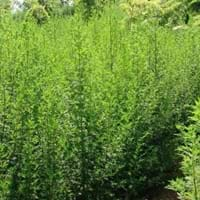Life Span
Annual
Perennial
Type
Shrub
Flowering Plants, Fruits, Trees
Origin
Not Available
Anatolia, Asia, Europe, Iran, Maghreb, Morocco, Norway, The Hiamalayas
Types
Not available
Flowering Cherries, Sour Cherries, Sand Cherries, Sweet Cherries, Capulin Cherries
Number of Varieties
Not Available
Habitat
Subtropical forests, Tropical Forests
Forest edges, Wild, Woods
USDA Hardiness Zone
Not Available
4-8
Sunset Zone
Not Available
4, 5, 6, 7, 15, 16, 17
Habit
Upright/Erect
Upright/Erect
Flower Color
Not Available
White
Flower Color Modifier
Not Available
Not Available
Fruit Color
Not Available
Red
Leaf Color in Spring
Not Available
Dark Green
Leaf Color in Summer
Not Available
Orange
Leaf Color in Fall
Not Available
Orange
Leaf Color in Winter
Not Available
Orange
Leaf Shape
bipinnate
Oblong
Plant Season
Spring, Summer, Fall
Spring, Summer
Sunlight
Full Sun, Partial Sun
Full Sun, Partial shade
Growth Rate
Medium
Medium
Type of Soil
Loam, Sand
Loamy, Well drained
The pH of Soil
Acidic, Neutral
Slightly Acidic
Soil Drainage
Well drained
Average
Bloom Time
Not Available
Early Spring, Spring
Tolerances
Drought, Salt
Heat And Humidity, Not Available
Where to Plant?
Ground, Pot
Ground
How to Plant?
Seedlings
Grafting, Seedlings, Transplanting
Plant Maintenance
Medium
Medium
Watering Requirements
Average Water Needs
Never Over-water, Over-watering can cause leaf problems or root diseases, Prefer drip-irrigation instead of Over-head watering, Water twice a day in the initial period
In Summer
Lots of watering
Lots of watering
In Spring
Moderate
Moderate
In Winter
Average Water
Average Water
Soil pH
Acidic, Neutral
Slightly Acidic
Soil Type
Loam, Sand
Loamy, Well drained
Soil Drainage Capacity
Well drained
Average
Sun Exposure
Full Sun, Partial Sun
Full Sun, Partial shade
Pruning
Remove damaged leaves, Remove dead branches, Remove dead leaves
Don't prune in the fall, Prune if you want to improve plant shape, Prune in late winter, Remove dead or diseased plant parts, Remove deadheads
Fertilizers
All-Purpose Liquid Fertilizer, Apply N-P-K
All-Purpose Liquid Fertilizer
Pests and Diseases
Aphids, Gray leaf blight, Root rot
Aphids, Bacterial Canker, Black Knot, Brown Rot, Caterpillars
Plant Tolerance
Drought, Salt
Drought
Flowers
Insignificant
Yes
Flower Petal Number
Not Available
Not Available
Fragrant Bark/Stem
Yes
No
Foliage Texture
Not Available
Not Available
Foliage Sheen
Not Available
Not Available
Attracts
Insects, Not Available
Birds
Allergy
Pollen
Swelling in the face
Aesthetic Uses
Not Available
Showy Purposes
Beauty Benefits
Skin inflammation
Not Available
Environmental Uses
Air purification
Air purification
Medicinal Uses
Antioxidants, Fever, Inflammation, Malaria
Arthritis, Gout, Kidney problems, Rheumatoid arthritis, Swelling
Part of Plant Used
Leaves
Flowers, Fruits
Other Uses
Medicinal oil, Oil is used for aromatherapy
Wood is used for making furniture
Used As Indoor Plant
No
No
Used As Outdoor Plant
Yes
Yes
Garden Design
Foundation, Mixed Border, Rock Garden, Wall
Not Available
Botanical Name
Artemisia annua
Prunus avium
Common Name
sweet wormwood, sweet annie, sweet sagewort, annual mugwort
Cherry Tree
In Hindi
Artemisia
चेरी का पेड़
In German
Artemisia
Kirschbaum
In French
Artemisia
Cerisier
In Spanish
Artemisia
Cerezo
In Greek
Αρτεμίσια
κερασιά
In Portuguese
Artemisia
árvore de cereja
In Polish
Artemisia
wiśniowe drzewo
In Latin
Artemisia
Cherry
Phylum
Magnoliophyta
Magnoliophyta
Class
Magnoliopsida
Magnoliopsida
Family
Asteraceae
Rosaceae
Clade
Angiosperms, Asterids, Eudicots
Angiosperms, Eudicots, Rosids
Tribe
Anthemideae
Not Available
Subfamily
Asteroideae
Not Available
Number of Species
Not Available
Difference Between Artemisia and Cherry Tree
If you are confused whether Artemisia or Cherry Tree are same, here are some features about those plants to help you choose better. Many people think that these two plants have the same characteristics, but one can see Artemisia and Cherry Tree Information and learn more about it. Fertilizers required for proper growth of Artemisia are All-Purpose Liquid Fertilizer and Apply N-P-K, whereas for Cherry Tree fertilizers required are All-Purpose Liquid Fertilizer. Hence, one should know the basic difference between Artemisia and Cherry Tree if you are planning to have them in your garden to enhance its beauty.
<
Flowering PlantsImportance of Artemisia and Cherry Tree
Want to have the most appropriate plant for your garden? You might want to know the importance of Artemisia and Cherry Tree. Basically, these two plants vary in many aspects. Compare Artemisia and Cherry Tree as they differ in many characteristics such as their life, care, benefits, facts, etc. Every gardener must at least have the slightest clue about the plants he wants to plant in his garden. Compare their benefits, which differ in many ways like facts and uses. The medicinal use of Artemisia is Antioxidants, Fever, Inflammation and Malaria whereas of Cherry Tree is Arthritis, Gout, Kidney problems, Rheumatoid arthritis and Swelling. Artemisia has beauty benefits as follows: Skin inflammation while Cherry Tree has beauty benefits as follows: Skin inflammation.
Compare Facts of Artemisia vs Cherry Tree
How to choose the best garden plant for your garden depending upon its facts? Here garden plant comparison will help you to solve this query. Compare the facts of Artemisia vs Cherry Tree and know which one to choose. As garden plants have benefits and other uses, allergy is also a major drawback of plants for some people. Allergic reactions of Artemisia are Pollen whereas of Cherry Tree have Swelling in the face respectively. Having a fruit bearing plant in your garden can be a plus point of your garden. Artemisia has no showy fruits and Cherry Tree has showy fruits. Also Artemisia is not flowering and Cherry Tree is flowering. You can compare Artemisia and Cherry Tree facts and facts of other plants too.





